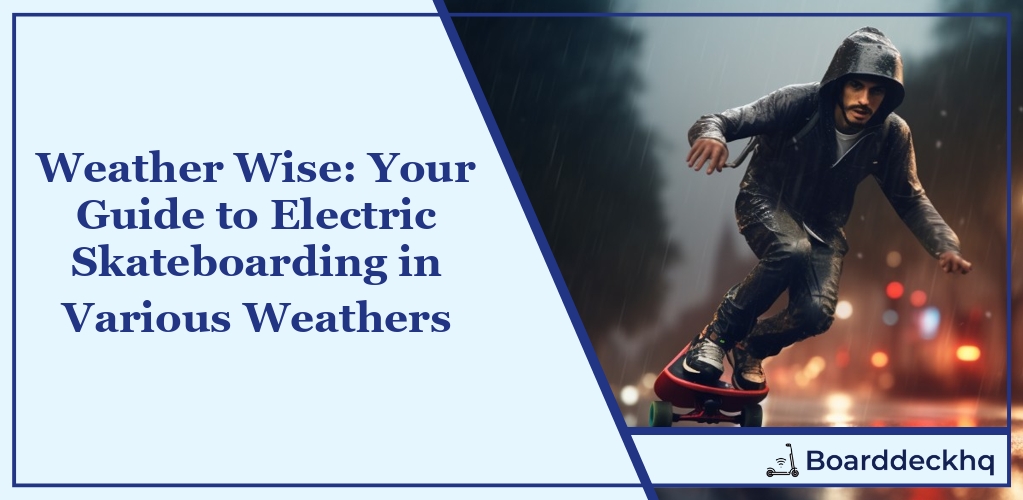Imagine yourself gliding effortlessly through traffic with a sleek and stealthy electric skateboard beneath your feet. But wait – the weather is far from perfect. You’re not deterred, however, because you’re well-equipped and prepared for any climate-related eventuality. This guide is your one-stop resource for embracing the thrill of electric skateboarding under all climatic conditions while prioritizing safety and helping to protect yourself and others.
What we’ll cover:
- Electric Skateboarding and Weather
- All-Weather Gear
- Wet Conditions Safety
- Handling Cold and Icy Roads
- Skateboarding in Hot and Dry Climates
- Low Visibility Conditions
- Windy Weather Riding
- Night Riding
- All-Weather Maintenance Tips
- Risk Recognition and Mitigation
Ready to be the master of elements on your electric skateboard? Let’s dive in, showing you not only how to conquer each weather condition but also why it’s essential to always be prepared!
Understanding Electric Skateboarding and Weather Challenges
Electric skateboarding has revolutionized the way we travel short distances, while enjoying the thrill of skateboarding. But it’s not without challenges, especially when it comes to weather conditions. It is crucial for those riding an electric skateboard to understand the complications that can arise due to varying weather conditions and how to navigate them safely.
Changing weather patterns can drastically impact electric skateboard function and safety. For instance, high temperatures can put extra stress on the battery and motor, while cold conditions can reduce battery life. Rainy or wet conditions can potentially damage the electric components of the skateboard, as well as reducing grip. Dusty and windy conditions can also adversely affect visibility and control of the skateboard, leading to potential accidents.
If weather conditions deteriorate while you’re out riding, consider taking a break until they improve.

Electric Skateboarding Weather Safety Tips
When it comes to skateboard safety, taking some proactive steps can help mitigate the potential risks. Here are some basic electric skateboarding safety tips for different weather contidions:
- Check weather forecasts before setting out on your electric skateboard. This will help you anticipate potential weather-related challenges.
- Keep your skateboard well-maintained. Regular inspection and maintenance can help prevent problems due to weather conditions.
- Be aware of your surroundings and adjust your speed based on the weather conditions.
- Wear appropriate gear for the weather. This will not only protect you from the elements but also ensure you maintain control over your skateboard.

Essential Gear for All-Weather Electric Skateboarding
Safety when riding an electric skateboard should always be a top priority, regardless of the weather conditions. Protective gear ensures that you are safe even if an accident does occurs.
Protective Gear
As a minimum, every rider should wear a helmet. A helmet can protect against serious head injuries in case of a fall or collision. Additionally, protective gear such as knee pads, elbow pads, and wrist guards can further minimize injury during accidents. For those wanting maximum protection, some brands also produce padded shorts, jackets and back protectors to minimize bruises, scrapes and even spinal injuries. You can never have too much protective gear!
Weather-Specific Gear
When you’re riding an electric skateboard in challenging weather conditions, wearing specific gear becomes more critical than ever. For instance, during rainy conditions, consider wearing waterproof clothing and shoes with non-slip soles. In hot weather, breathable materials can keep you cool and prevent overheating, allowing you to stay focused on your ride.
Visibility Gear
Visibility is crucial for top-level electric skateboard safety. Headlamps and reflective clothing can help you see and be seen by others, especially in low-light conditions or during particularly unpleasant weather.
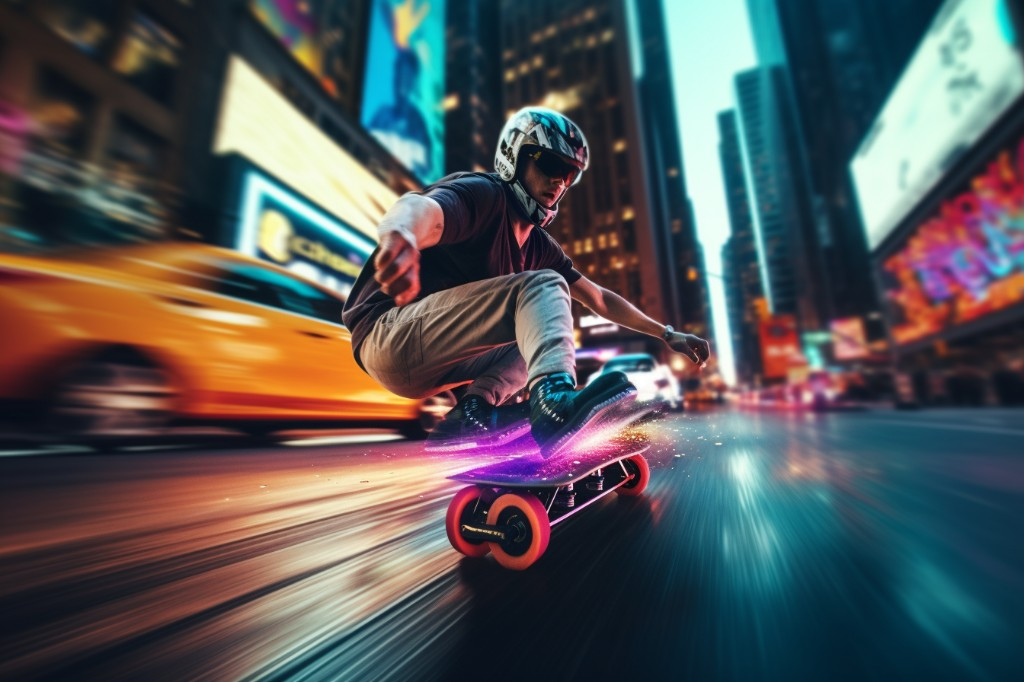
Maximising Safety in Wet Conditions
While many people avoid using their electric skateboards during wet weather due to the risk of slipping or damaging their board, sometimes you might find yourself caught up in unexpected rain while out riding.
Riding Tips for Wet Conditions
The key aspect of electric skateboarding in wet conditions is maintaining control over your board. Be cautious about your speed and avoid sharp turns that could lead to slipping. Also, keep in mind that stopping distances may be longer on wet surfaces, so keep your distance from others and maintain a manageable speed.
Preventing Water Damage
Water damage is a legitimate concern when riding an electric skateboard in wet conditions. Therefore, preventing electric skateboard water damage should be a top priority. If your board isn’t designed to be water-resistant, consider using a waterproof cover or spray to protect the electronic components. Otherwise, you’ll need to be super vigilant in checking weather forecasts and only venturing out in dry conditions.
Visibility Considerations
Visibility is another critical factor when aiming for safe electric skateboarding on wet surfaces. As mentioned earlier, headlamps and reflective clothing can increase your visibility to other road users. However, you should be extra cautious when crossing intersections or navigating around corners where visibility may be further reduced.
Top Electric Skateboard Safety Tips
Lastly, here are some additional top electric skateboard safety tips for wet conditions:
- Check your skateboard’s tires regularly for any signs of wear or damage that could affect their grip on wet surfaces.
- Avoid puddles wherever possible as they may hide potential hazards such as potholes or debris.
- If you have to ride at night, make sure you have adequate lighting not just for visibility but also to signal your presence to others.
- When you finish your ride, remember to properly dry off your board to prevent corrosion or damage to the electronic components.
By following these tips, you’ll be better prepared to ride your electric skateboard safely through the challenges presented by various weather conditions.

Dealing with Cold and Icy Roads
Skateboarding in cold weather conditions is no easy feat, especially when the roads are icy and slippery. Yet there are many ways to ensure skateboarding safety in snow. Remember, the key to skateboarding in cold weather is preparation, so read on to find out what key preparations can support the performance of your board in cold and icy conditions.
Tyre Selection
Choosing the right tyres for your skateboard can make a world of difference in slippery conditions. Tyres with greater tread depth provide better traction and control on icy roads. The use of winter or studded tyres can also improve stability and reduce the likelihood of falls.
Fall Prevention Strategies
Unfortunately, accidents can occur when riding your electric skateboard. In order to prevent unnecessary accidents or falls, it’s advisable to adjust your riding style in cold weather. For instance, avoid making sharp turns or sudden stops, as these actions can cause you to lose control and slip. However, if you do succumb to the conditions and take a tumble, wearing protective gear, such as elbow pads, knee pads, and a helmet, can cushion your fall and prevent serious injuries.
Battery Care
Electric skateboards rely heavily on battery power to function, and cold weather can significantly reduce the battery life. It’s not uncommon for the battery capacity to decrease by up to 40% when the temperature drops below freezing. To mitigate this, try to maintain your skateboard battery at room temperature before riding and aim not to be riding in extreme low temperatures for too long.
Finally, it’s possibly to prolong the lifespan of your electric skateboard battery with proper care in cold weather conditions. After each ride, ensure you store your skateboard in a warm indoor space rather than leaving it outside in the cold. This one simple action will help maintain the battery life.

Tips for Skateboarding in Hot and Dry Climates
Riding an electric skateboard in hot and dry climates presents different challenges as compared to cold weather. Here are some strategies to handle these conditions effectively.
Managing Heat for Your Electric Skateboard
Despite the thrill of skateboarding under the hot sun, it’s essential to consider electric skateboard safety in extreme heat. High heat levels may not only affect your comfort but also wear down your skateboard’s components quicker than usual.
Excessively hot weather conditions can lead to overheating of the skateboard’s batteries and motors, diminishing its performance. In extreme cases, it may even pose a fire risk, which is why electric skateboard fire safety in hot weather is paramount. Always ensure that your electric skateboard is stored in a cool area when not in use.
Hydration and Gear Selection
When it comes to skateboarding in hot weather, hydration is key. Always carry a water bottle with you and keep sipping at regular intervals.
In terms of what to wear while skateboarding, light-colored clothes that reflect sunlight are preferred over dark ones that absorb heat. And although they might be tempting in hot weather, it’s not safe to wear flip-flops or sandals while skateboarding due to the lack of grip they offer. Instead, opt for breathable sneakers that provide both comfort and grip to aid safety.

Navigating Foggy and Low Visibility Conditions
Skateboarding amidst foggy conditions demands extra attention due to decreased visibility, resulting in a higher probability of an accident or injury.
Importance of Good Lighting
Good lighting is crucial for skateboarding safety in foggy weather. Using an electric skateboard headlamp for foggy weather can illuminate your path and make you visible to others on the road. Additionally, consider using tail lights and reflectors for added visibility.
Reflective Gear
Reflective gear plays a huge role in any skateboarder’s safety under low visibility conditions. Reflective vests, stickers, or wristbands can help you stand out better amidst foggy conditions, alerting drivers of your presence on the road, and increasing your level of safety.
Riding Strategies
When it comes to strategies for safer riding under low visibility conditions, maintaining a slow speed can reduce the chances of an accident since it allows for more reaction time. Also important is ensuring that you ride your electric skateboard on familiar routes where you know the terrain well. Avoid new routes that may have unexpected obstacles or traffic patterns; save these for a clear day when you can explore to your heart’s content.
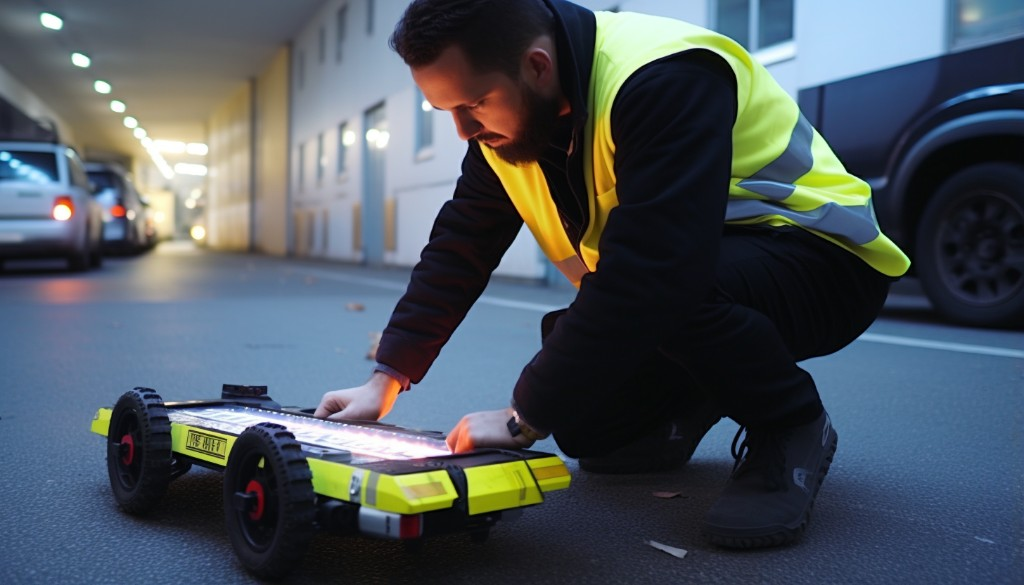
Safely Riding Your Electric Skateboard in Windy Weather
Skateboarding in windy conditions can be quite an adventure, but it also comes with a set of challenges. The wind affects the stability and speed control of your ride in multiple ways, so riding an electric skateboard in such weather requires certain precautions to ensure safety and control.
Maintaining Stability
When it comes to maintaining balance on your skateboard during windy weather, the key lies in your stance and body posture. The stronger the wind, the lower and wider your stance should be. Spread out your feet to distribute weight evenly and bend your knees to lower your center of gravity. This will help you maintain stability.
Speed Control
Appropriate electric skateboard acceleration in weather changes is crucial to ensure safety. Windy conditions can cause rapid shifts in speed that can throw you off balance. Using the electric skateboard’s speed controller wisely is essential. When the wind is against you, expect the board to decelerate. Conversely, when the wind is behind you, be prepared for quick acceleration.
Protective Gear and Clothing
While riding an electric skateboard in windy weather, wearing appropriate gear can make a significant difference. A windproof jacket can keep the chilly air off your skin, reducing distractions from the cold. Remember to put on a helmet and other protective gear, like elbow and knee pads, as this can protect you if a sudden gust of wind causes a fall.
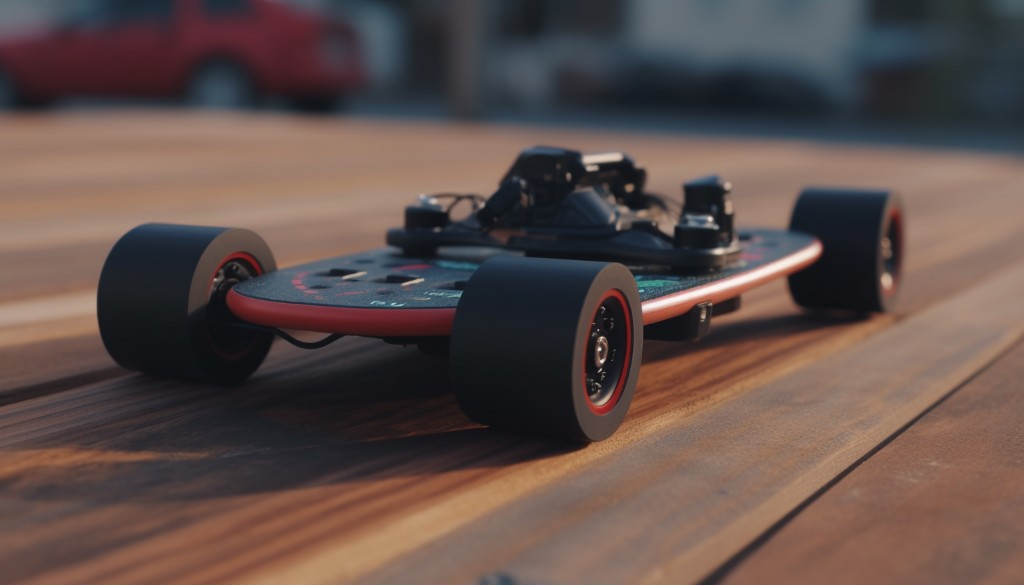
Night Riding Considerations
Riding your electric skateboard after sunset or before sunrise requires some additional considerations to optimize safety and visibility. From picking the right gear to adjusting your ride strategies, there are several factors to keep in mind.
Visibility and Lighting
One of the most critical electric skateboarding tips for safe night riding is ensuring maximum visibility. The rider should be clearly visible to others, and the path ahead should be well lit. You can achieve this by using front and rear lights on your board and wearing reflective gear or LED strips.
Ride Strategies
To ride at night safely, it would be wise to stick to familiar routes where you know the terrain well. By doing so, you can anticipate potential obstacles that may be hard to see in the dark. Additionally, taking slower turns and maintaining a lower speed can reduce the chance of accidents.
Traffic Flow Considerations
Evening hours often come with a different traffic flow compared to daylight hours. To avoid heavy traffic, it is advisable to choose less busy roads or dedicated bike lanes for your ride.

Maintenance Tips for Weather Exposed Electric Skateboards
After experiencing extreme weather conditions, your skateboard might need some extra care. Regular maintenance checks are crucial to ensure your board’s longevity and safety.
Battery Check
Extreme weather conditions can take a toll on your electric skateboard’s battery life. Therefore, it’s essential to check the battery after every ride in harsh conditions and ensure it’s charged properly before heading out again.
Wheel Inspection
Your wheels bear the brunt of rough roads that are common after storms or heavy rain. Check your skateboard wheels for signs of wear and tear, punctures or embedded debris that could affect your ride.
Brakes and Throttle Check
A defect with your electric skateboard’s brakes or throttle can lead to serious accidents. Therefore, regular checks are necessary to ensure their optimal functioning and your safety.
Regular Cleaning
Cleaning your electric skateboard after exposure to extreme weather conditions is also necessary. Removing dirt or mud from wheels and other parts helps preserve their condition and performance.
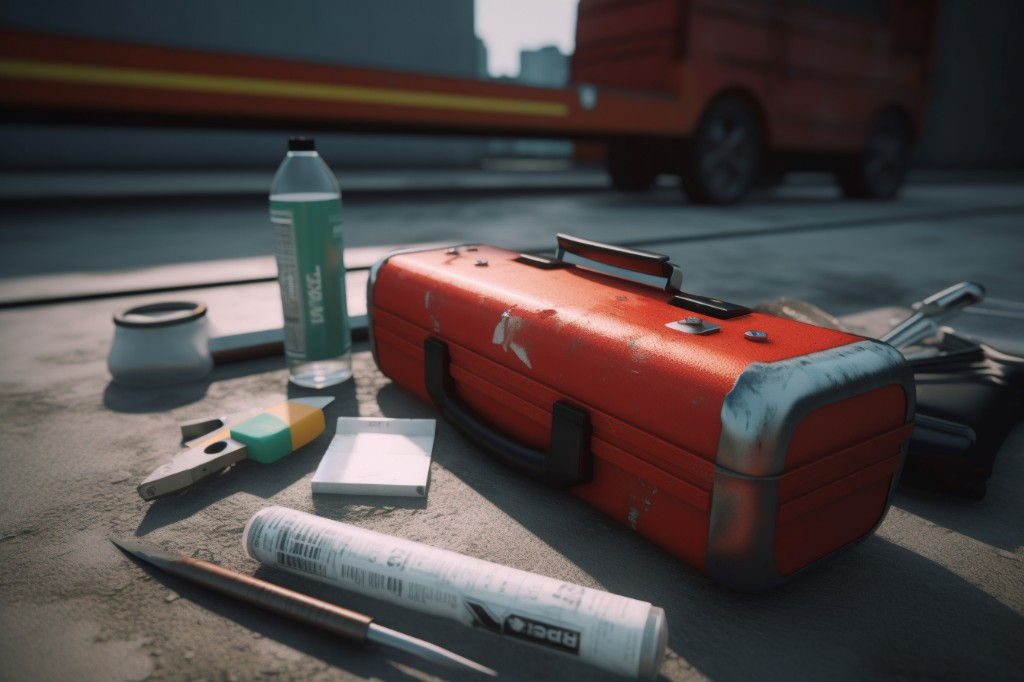
Closing Thoughts
Electric skateboarding is an exhilarating experience, but it also requires a certain level of care and knowledge to ensure a safe and comfortable ride. Weather conditions like extreme heat or cold can affect your skateboard’s battery life, hence understanding and adjusting your riding habits according to weather changes are especially important. There are a number of other factors to consider which can also help combat poor weather conditions; appropriate tyre selection, weather-specific protective gear, and adopting safe riding strategies. All of these elements can significantly improve your riding experience and safety. Safety should always be your priority, so having a clear understanding of the common risks associated with electric skateboarding and the ways to mitigate them is essential.
Frequently Asked Questions
What’s the best way to maintain my electric skateboard after riding in the rain?
After riding in the rain, ensure to wipe off any water from your electric skateboard immediately with a dry cloth. Avoid storing it in damp or humid places to prevent rust or damage to the battery and electronic components. Regularly check for any damage or loose parts.
How does cold weather affect my skateboard’s battery life?
Cold weather can negatively impact your skateboard’s battery life, causing it to drain faster. Lithium-ion batteries, commonly used in electric skateboards, perform best at room temperature. Therefore, try to store and charge your board in room-temperature conditions, and avoid leaving it out in the cold.
Are there special tyres for electric skateboards for wet or icy conditions?
Yes, there are special tyres designed for wet or icy conditions. These tyres often have deeper treads for better traction and are made of softer rubber compounds for enhanced grip on slippery surfaces.
What additional gear should I consider when skateboarding at night?
When skateboarding at night, it’s crucial to have a good set of lights — not just so you can see where you’re going, but also to ensure others can see you. Reflective clothing or accessories can also enhance visibility. Always ensure your equipment is in good working condition before setting off.
What are common risks associated with electric skateboarding and how can I mitigate them?
Common risks include falls due to high speeds or obstacles, accidents caused by lack of visibility at night, and equipment failure. You can mitigate these risks by wearing appropriate safety gear such as helmets, knee pads, and elbow pads; using lights and reflective gear at night; regularly checking and maintaining your skateboard’s components; and adhering to local regulations regarding electric skateboard use.
